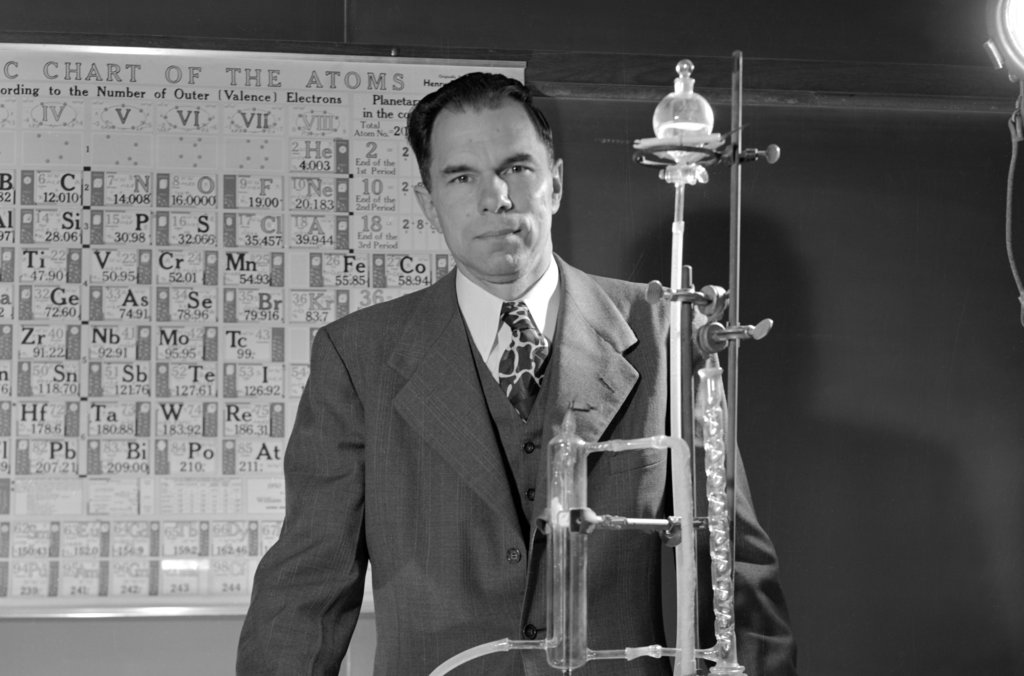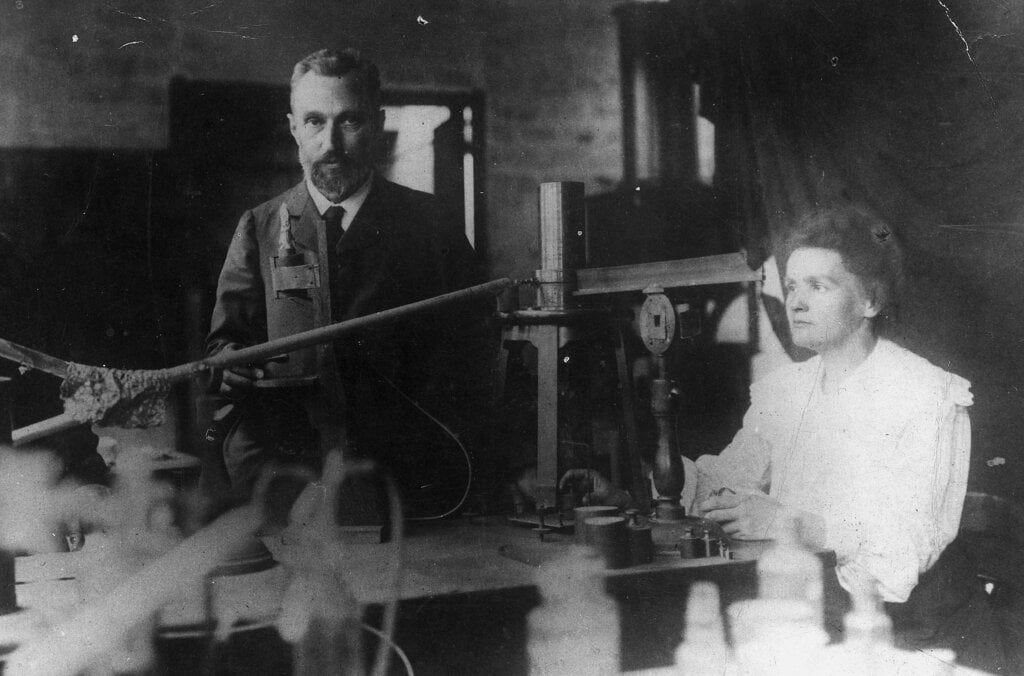Ever since it was proposed by Dmitri Mendeleev in 1869, the periodic table has been at the core of chemistry. Mendeleev’s table not only classified the known elements, but enabled him to predict those that were missing, along with their physical and chemical properties.
While Mendeleev was never awarded the Nobel Prize (he was nominated in 1905, 1906 and 1907) his work paved the way for many other laureates who went onto be recognised for their elemental discoveries. Let’s take a look at some of the Nobel Prize laureates who have contributed to this scientific staple.

Glenn T. Seaborg standing in front of the periodic table with the ion exchanger illusion column of actnide elements, 19 May 1950.
Photo courtesy of Berkeley Lab
In 1985, in the New York Times, Glenn Seaborg published ‘Man’s First Glimpse of Plutonium’, the story of how he and colleagues synthesised a brand new element.
“On the stormy night of Feb. 23, 1941, Art Wahl performed the oxidation that gave us proof that what we had made was chemically different from all other known elements.”
It was a discovery that earned Seaborg and Edwin McMillan the 1951 Nobel Prize in Chemistry.
The discovery of plutonium followed that of neptunium, and would open the door to the transuranium elements – those that come after uranium in the periodic table. However Seaborg and McMillan were far from the first Nobel Prize laureates to be recognised for their work in discovering elements – pure substances composed of just one type of atom.
The honour of being the first Nobel Prize laureates to be awarded the prize for their contributions to the periodic table instead goes to William Ramsay and Lord Rayleigh.
Lord Rayleigh was interested in developing methods for studying the physical properties of gases in the atmosphere. However when he compared nitrogen extracted from air with nitrogen extracted from chemical compounds, Lord Rayleigh found that the nitrogen from air was heavier. He concluded that the air must contain another, previously unknown substance.
In 1894 he, along with Ramsay, succeeded in extracting the previously unknown element, argon, in pure form. They named it after the Greek word for lazy as they found it was extremely unreactive.
The pair’s discovery made them realise that the recently formed periodic table was missing a whole class of elements – the inert noble gases. After isolating another noble gas – helium – Ramsay predicted others based on the periodic table and went on to establish the existence of neon, krypton and xenon.
Another important elemental discovery was made by perhaps one of the most famous contributors to the periodic table: Marie Curie, along with her husband Pierre.
The Curies were interested in investigating a new phenomenon – radioactivity. Their studies led them to the ore pitchblend which they found was four to five times more active than the uranium they had been investigating. After much experimenting they started to realise that maybe there were unknown, new elements in pitchblend. In the summer of 1898 their hard work was rewarded when they discovered a brand new element, polonium.
After a few months of work they had a second discovery to add to the periodic table. They had found an additional highly active substance that behaved chemically almost like pure barium. They suggested the name of radium for the new element. The couple were jointly awarded the Nobel Prize in Physics in 1903, for their work on radioactivity. Marie later went onto receive a second individual prize in chemistry in 1911 for her part in the discovery of both radium and polonium, Pierre having passed away in 1906.

Pierre and Marie Curie in the “hangar” at l’Ecole de physique et chimie industrielles in Paris, France, where they made their discovery. Photo taken 1898.
© Association Curie Joliot-Curie. Photographer unknown
When naming their discoveries, the Curies used both places and science as their inspiration. It was an idea that was also used by other scientists – Hafnium is named after the Latin name of Copenhagen, where laureate George de Hevesy discovered the element.
“We suggest that it should be called polonium after the name of the country of origin of one of us.”
But if you take a look at the periodic table you can see another way laureates have left their mark. Many elements bear the name of Nobel Prize laureates themselves. Albert Einstein, Enrico Fermi, Ernest Rutherford and Niels Bohr all have elements named after them. When naming one of his discoveries Glenn Seaborg looked to the scientists that had come before him. As a result the new element Curium was named after the Curies. In turn Seaborg himself has an element named after him although it was a controversial choice as he was still alive at the time the name was proposed.
Today no less than eight elements bear the names of Nobel Prize laureates, with a further element – Nobelium – named after Alfred Nobel. In many ways Nobel Prize laureates have played an important part in the creation of the periodic table as we know it today. Will they play a part in its future? That is still to be discovered.
First published June 2019